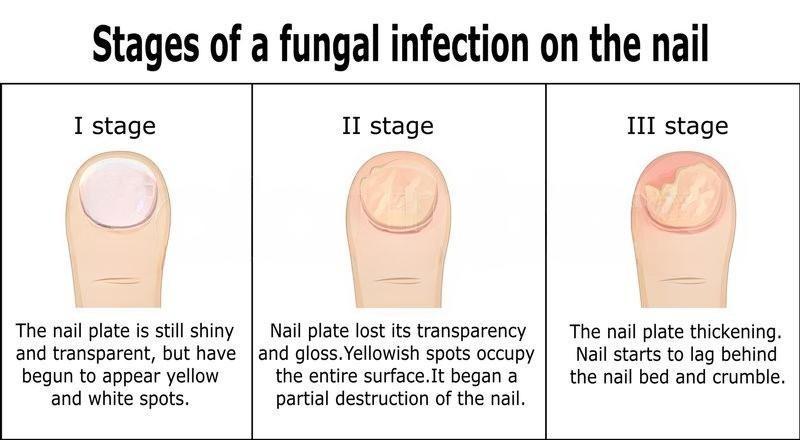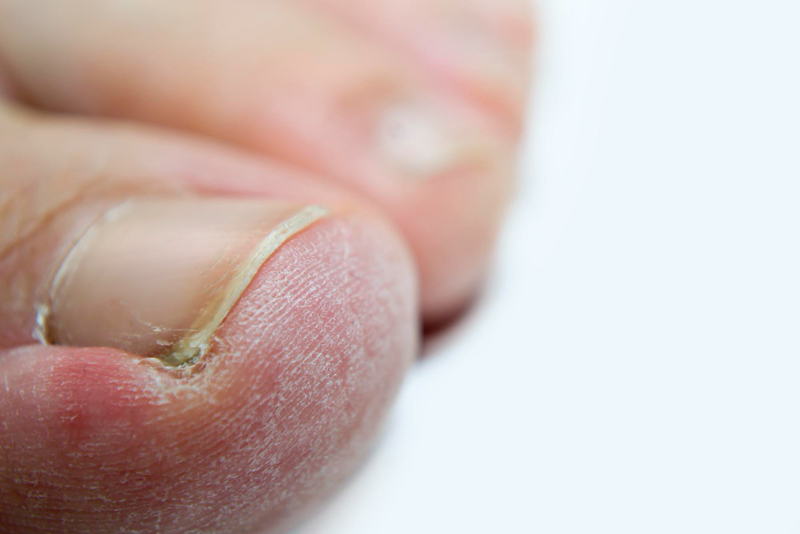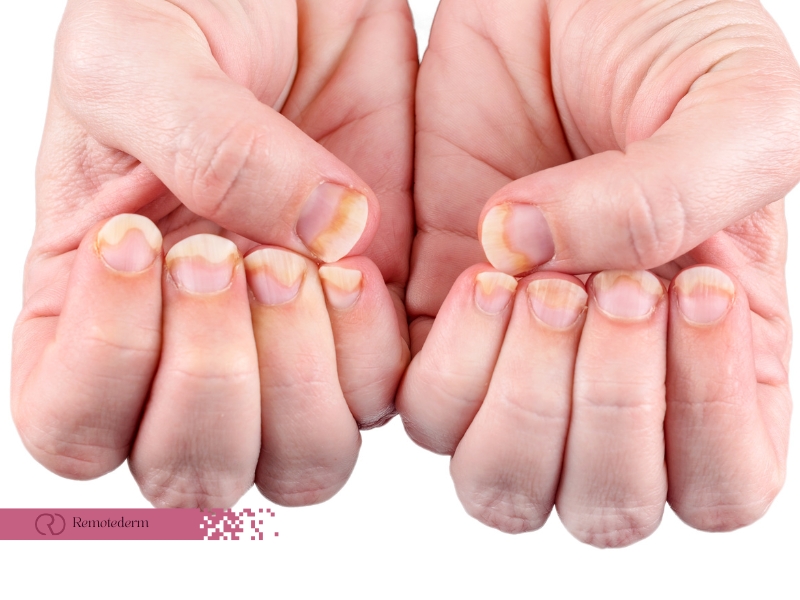Understanding nail fungus stages is essential for managing onychomycosis, a common condition affecting millions annually. Early identification of these stages can improve treatment outcomes and prevent the infection from worsening. This article covers the causes of nail fungus, its progression, and key prevention and treatment strategies. Recognizing the signs of nail fungus at each stage is crucial for effective care and healthy nails, whether you’re in Canada or elsewhere.
Causes of Nail Fungus
The primary cause of nail fungus, also referred to as onychomycosis in medicine, is a class of fungi known as dermatophytes. Because these fungi like warm, humid conditions, they are often found in gyms, showers, and swimming pools. This is especially true in the context of Canada, where most people use public recreational facilities. However, mold and yeast can also play a role in the causation of nail fungal infections. Nail fungus: It is possible that the following causes, if kept in mind, can help to prevent and treat this condition effectively :
- Moisture Exposure: Frequent and prolonged exposure to wet environments can soften the nails to a point where fungal infections can readily occur.
- Tight Footwear: Specifically, tight shoes that do not leave room for ventilation, are said to create a damp environment that favors the growth and multiplication of fungi.
- Damaged Nails: Nails that are cracked or traumatized are more vulnerable to fungal infections because the underlying imperfections create doorways for the fungi to enter the nail bed.
- Poor Hygiene: Not keeping the feet and nails clean and dry can increase the risk of developing nail fungus.
- Communal Spaces: Walking barefoot in communal damp areas such as locker rooms, saunas, and public pools can lead to exposure to fungi.
- Health Conditions: A person with diabetes, blood circulation issues, or a weak immune system is at higher risk of getting nail fungus.
These factors can be worked mainly upon to reduce the possibility of developing nail fungus and to keep the nails healthy and good-looking.
Understanding Nail Fungus Stages
In this section, we will be taking a closer look at the progress of nail fungus stages. It is essential to know the steps so the disease can be healed and prevented in time. We would be taking the reader through the subtle beginnings, the worsening symptoms, and the significant deterioration if the condition is left untreated.

Initial Stage: Unnoticeable Beginnings
Early on in nail fungus, the signs and symptoms are so minimal that it often goes undisturbed or unnoticed. This is important because early diagnosis can stop the spread of infection and is more easily managed than if it goes unnoticed for a more extended period.
Early Signs
In the initial stage of nail fungus, the signs can be so minor that they often go unnoticed. However, being aware of these subtle changes can help in early detection and easier management.
- Subtle discoloration often begins at the nail’s tip—look for white or yellow spots.
- The nail may be a little weaker and distorted from a slight growth of fungus.
Identification Tips
Detecting the moment when a nail is infected with nail fungus in its very early stage requires close observation of details. Consider the following few observations:
- Check the nails occasionally, especially after they have been wet.
- The comparison of nails with early-stage nail fungus pictures might help in the recognition of these subtle changes.
Middle Stage: Worsening Symptoms
When the fungus progresses, it reaches the stage in which the symptoms become more predominant and perhaps more disruptive.
Development
The symptoms of onychomycosis progress as the nail fungus progresses. This proves the point that the nail fungus differences should be recognized in time.
- The fungus spreads deeper into the nails, causing them to discolor, thicken, and distort.
- Nails may begin to lift off the nail bed, forming spaces that can provide a shelter for more fungal growth.
Symptoms to Watch For
At this stage, the symptoms start becoming more irritating. Such things to look out for are:
- Nails are more brittle, and they tend to break and split.
- Irritation and itching at the skin bordering on the nails particularly when pressure is exerted on them.
Advanced Stage: Significant Deterioration
During the advanced stages of nail fungus infection, the symptoms can cause great discomfort and pain; That section underscores how serious these symptoms are—how expensive to the sufferer in dollars or missed days of work and, possibly, how desperately urgent the need for a level of treatment much more aggressive and desperation-driven than the patient is currently being offered.
Severe Symptoms
With a severe case of nail fungus, the discomfort can be so severe that it affects daily activities. However, when you start experiencing symptoms, early and aggressive therapy is needed.
- Total yellow to brown nail discolouration
- Even more pronounced thickening and rough texture which makes the thickened skin harder to trim and pressure points under shoes due to increased bulk of callused skin.
Impact on Quality of Life
The advanced stage changes the appearance of nails, and also worsens the condition, impacting overall well-being. Some important considerations:
- The surrounding area is often painful and there may be difficulty walking and wearing shoes.
- Risk of secondary bacterial infections (if the nail bed separates).
Effective Nail Care and Treatment Options
The successful treatment of each of nail fungus stages needs a concerted campaign of nail care and timely treatment. This section details the best practices and treatment options to handle the various nail fungus stages, supplemented by references to a nail diseases chart for better understanding.

Preventative Measures
Fungus can invade your nails, but here is how you can stop nail fungus from even starting yet:
- Hygiene: Keep your nails clean and dry to prevent fungal infection.
- Trimming: It is important to trim nails straight across to avoid trauma and allow irregular nail surfaces which can harbor fungus.
- Protective Footwear: Use protective waterproof sandals in communal wet areas (pools, gym showers) so as not to be exposed to fungal spores.
Treatment Strategies
If you can catch the early nail fungus stages while it is still in its early stages, seeking treatment can prevent the condition from getting worse.
- Topical Treatments: Antifungal creams or lacquers used to paint the infected nails directly. These work best when the nail fungus is in its early stages.
- Oral Medications: In more challenging stages represented in the nail disease chart, an oral antifungal medication may be required to address the fungus more systematically.
- Online dermatology services: If you are in Canada, you can shorten the time to diagnosis and treatment by taking advantage of online nail fungus treatment. The ease of use and rapid communication with specialists for diagnosis and assessment of the treatment required based on the stage and severity of the infection are key features of such platforms.
- Advanced treatments: If traditional treatments are ineffective, laser therapy or partial nail removal can get rid of the fungus and the infected areas.
This way, the progress of nail fungus can already be controlled by proper adjustments in taking care of the nail at every level of the infection.
Final Thoughts
Nail fungus is a common condition in Canada that can be difficult to treat, but understanding nail fungus stages is crucial for effective management and prevention. By familiarizing yourself with these stages, along with pictures and a nail disease chart, you’ll be able to recognize the progression of fungal nails and take action to prevent further damage. Early detection and pre-emptive care are your best defenses against the condition advancing. Regular checks are essential for identifying problems early, enabling prompt treatment and improving the chances of successful outcomes. Recognizing the various nail fungus stages helps ensure timely intervention, whether in urban or rural areas across Canada.
FAQs
1. Does Weather Affect Nail Fungus Growth?
Indeed, wet/humid conditions are always preferred for any fungal infections and exactly the same thing happens with nail fungus.
2. How Long Does Nail Fungus Take to Be Cured with Treatment?
Depending upon the therapy used, it can take several months to a year for curing nail fungus completely.
3. Do some people have a genetic predisposition to nail fungus?
Indeed, genetic factors affect vulnerability to skin fungal infections and also those that affect the nails.
4. Does Nail Fungus Cause Permanent Nail Damage?
In some cases, nail fungus can permanently damage the nail bed and nail structure leading to a possibility of chronic infection and nail loss.
